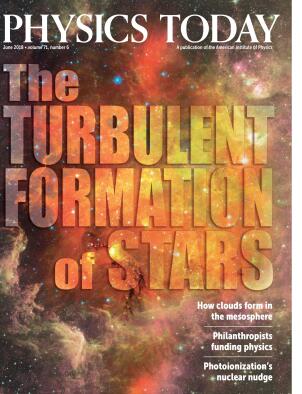New books & media
DOI: 10.1063/PT.3.3952
Max the Demon vs. Entropy of Doom
Max the Demon vs. Entropy of Doom, Assa Auerbach and Richard Codor, Loose Line Productions, 2017, $24.95 (paper)
Nerdy superhero Max the Demon and gifted scientist Julie Calore team up to save the world from global warming in this educational graphic novel aimed at middle and high school students. Max, a being from the fictional world of Tachyonia, is sent back in time to meet some of Earth’s greatest physicists and learn about energy, heat, and entropy. Then he and Julie collaborate on an alternative to fossil-fuel burning, all the while battling villains who try to steal their work. The book is filled with adventure and intrigue—plus a thought experiment by James Clerk Maxwell and a whole lot more physics. —

Spaceflight in the Shuttle Era and Beyond: Redefining Humanity’s Purpose in Space
Spaceflight in the Shuttle Era and Beyond: Redefining Humanity’s Purpose in Space, Valerie Neal, Yale U. Press, 2017, $40.00
From 1981 to 2011, the space shuttle was the symbol of US spaceflight. In her latest book, Valerie Neal, chair of the space history department at the Smithsonian National Air and Space Museum, chronicles the shuttle era. She explores the meaning of human spaceflight during that era by examining the images and rhetoric surrounding the space shuttle when it was active. Optimism about the shuttle program in the 1970s was overshadowed by frustration and criticism in the 1980s and 1990s; in the new century, Neal writes, discussion about the program reveals uncertainty about the nation’s future in space. The book concludes with a fascinating account of how the Air and Space Museum stores and preserves space shuttles, along with a meditation about what it means for the space-shuttle era to pass into memory. —

Where the River Flows: Scientific Reflections on Earth’s Waterways
Where the River Flows: Scientific Reflections on Earth’s Waterways, Sean W. Fleming, Princeton U. Press, 2017, $26.95
Not only are rivers an integral part of Earth’s hydrologic cycle, they also fulfill myriad functions for Earth’s inhabitants. They deliver fresh drinking water, irrigate crops, support wildlife ecosystems, supply hydroelectric power, provide pathways for transportation, and delineate geographic borders. In this journey along the planet’s multifarious waterways, geophysicist Sean Fleming discusses river locations, the uses of mathematical and statistical physics to study water-flow variations over time and space, and the interrelationships of rivers with ecosystems, weather, and astronomical phenomena. The book also serves as a cautionary tale: As the human population continues to grow and contribute to water shortages and other environmental problems, water-resource science will gain in importance as a means of averting global catastrophe. —

The Science of Time 2016: Time in Astronomy & Society, Past, Present and Future
The Science of Time 2016: Time in Astronomy & Society, Past, Present and Future, Elisa Felicitas Arias, Ludwig Combrinck, Pavel Gabor, Catherine Hohenkerk, P. Kenneth Seidelmann, eds., Springer
This collection of papers originated with a symposium called “The Science of Time” at Harvard University in June 2016. The collection, which aims to inform timekeeping practices for astronomers and society as a whole, draws on scholarship from the humanities and the sciences to consider the past, present, and future of the science of time. Readers excited about a particular author or essay title should be aware that some of the talks from the symposium are only included in abstract form. —

The Physics of Star Wars: The Science Behind a Galaxy Far, Far Away
The Physics of Star Wars: The Science Behind a Galaxy Far, Far Away, Patrick Johnson, Simon & Schuster, 2017, $16.99 (paper)
Can hundreds of different alien life-forms really exist in a single galaxy? Is it possible for twins Luke and Leia to have aged differently due to space travel? Could we one day be able to create a lightsaber? As part of his mission to communicate science to nonscientists, physicist Patrick Johnson uses the fictional world of Star Wars to explore real-life science. The book is divided into categorized topics such as “Biodiversity in the Galaxy” and “Hover Car Traffic,” each beginning with a brief introduction and backstory, followed by an analysis of the physics involved in the Star Wars universe compared with current science and technology here on Earth. Aimed at a general audience, The Physics of Star Wars could stimulate some thought-provoking discussions. —

Star Theatre: The Story of the Planetarium
Star Theatre: The Story of the Planetarium, William Firebrace, Reaktion Books, 2017, $40.00
Elaborately decorated domed ceilings, armillary spheres, and orreries depicting the heavens and demonstrating the movement of the planets have existed for more than a millennium. The modern-day planetarium with its hemispherical screen and projection system, however, is a decidedly 20th-century invention, first devised in the 1920s by engineer Walther Bauersfeld in Jena, Germany. Bauersfeld’s star theater was such a success that others quickly began to spring up all over the world. In this nicely illustrated yet slender volume, architect William Firebrace traces the history of the planetarium, discusses some of the world’s most famous examples, and considers how planetariums evolved in the 21st century in response to new technologies and new cosmological discoveries. —

CYNTHIA CUMMINGS

Critical Assembly: Poems of the Manhattan Project
Critical Assembly: Poems of the Manhattan Project, John Canaday, U. New Mexico Press, 2017, $19.95 (paper)
In this thought-provoking volume, poet John Canaday considers the history and legacy of the Manhattan Project. Each poem is written from the point of view of a historical figure associated with the development of the US atomic bomb. Canaday’s poems explore what the project might have looked like not only to well-known figures such as J. Robert Oppenheimer and Leslie Groves, but to people like laboratory assistant Antonio Martinez, site manager Dorothy McKibbin, and local resident Edith Warner, who ran a tearoom near Los Alamos. The collection is stylistically diverse and accompanied by a helpful set of appendices, including a guide to the people and terms each poem references and a bibliography of further reading on the Manhattan Project. —

